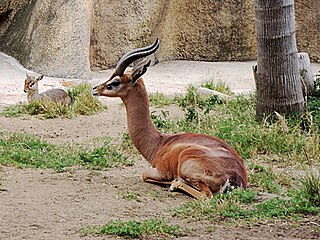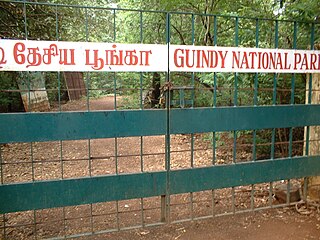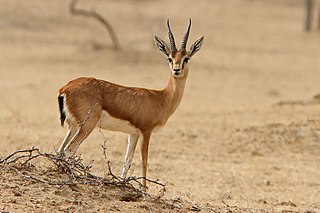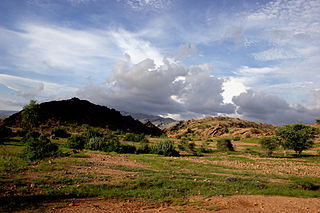
The term antelope refers to numerous extant or recently extinct species of the ruminant artiodactyl family Bovidae that are indigenous to most of Africa, India, the Middle East, Central Asia, and a small area of Eastern Europe. Antelopes do not form a monophyletic group, as some antelopes are more closely related to other bovid groups, like bovines, goats, and sheep, than to other antelopes.
Antelope are herbivorous mammals.

The gerenuk, also known as the giraffe gazelle, is a long-necked, medium-sized antelope found in parts of East Africa. The sole member of the genus Litocranius, the gerenuk was first described by the naturalist Victor Brooke in 1879. It is characterised by its long, slender neck and limbs. The antelope is 80–105 centimetres tall, and weighs between 18 and 52 kilograms. Two types of colouration are clearly visible on the smooth coat: the reddish brown back or the "saddle", and the lighter flanks, fawn to buff. The horns, present only on males, are lyre-shaped. Curving backward then slightly forward, these measure 25–44 cm.

The blackbuck, also known as the Indian antelope, is a medium-sized antelope native to India and Nepal. It inhabits grassy plains and lightly forested areas with perennial water sources. It stands up to 74 to 84 cm high at the shoulder. Males weigh 20–57 kg (44–126 lb), with an average of 38 kg (84 lb). Females are lighter, weighing 20–33 kg (44–73 lb) or 27 kg (60 lb) on average. Males have 35–75 cm (14–30 in) long corkscrew horns, and females occasionally develop horns, as well. The white fur on the chin and around the eyes is in sharp contrast with the black stripes on the face. Both sexes’ coats feature a two-tone colouration; in males, the majority of the body is dark brown to black, with white circles around the eyes, white ears and tail, and the belly, lower jaw, and inner legs also white. Females and juveniles are yellowish-fawn to tan and display the same white areas, only with more of a beige tone than the males. Females also feature a more pronounced horizontal white side-stripe, starting around the shoulder and ending at the rump. The blackbuck is the sole living member of the genus Antilope and was described by Carl Linnaeus in 1758. Two subspecies are recognized.

The Sivalik Hills, also known as the Shivalik Hills and Churia Hills, are a mountain range of the outer Himalayas that stretches over about 2,400 km (1,500 mi) from the Indus River eastwards close to the Brahmaputra River, spanning the northern parts of the Indian subcontinent. It is 10–50 km (6.2–31.1 mi) wide with an average elevation of 1,500–2,000 m (4,900–6,600 ft). Between the Teesta and Raidāk Rivers in Assam is a gap of about 90 km (56 mi). The literal translation of "Sivalik" is 'tresses of Shiva'. Sivalik region is home to the Soanian archaeological culture. The hills are well known for their Neogene and Pleistocene aged vertebrate fossils.

The antilopines are even-toed ungulates belonging to the subfamily Antilopinae of the family Bovidae. The members of tribe Antilopini are often referred to as true antelopes, and include the gazelles, blackbucks, springboks, gerenuks, dibatags, and Central Asian gazelles. True antelopes occur in much of Africa and Asia, with the highest concentration of species occurring in East Africa in Sudan, Eritrea, Ethiopia, Somalia, Kenya, and Tanzania. The saiga inhabits Central and Western Asia, mostly in regions from the Tibetan Plateau and north of the Indian Subcontinent. The dwarf antelope species of tribe Neotragini live entirely in sub-Saharan Africa.

The Northwestern thorn scrub forests, presently known as Aravalli west thorn scrub forests, is a xeric shrubland ecoregion of Pakistan and Northern India, stretching along the border lowlands and hills between the two countries. Once covered in deciduous forest, this ecoregion has been degraded through agriculture and the extraction of timber so that it currently has a scanty covering of thorny scrub dominated by such trees as Acacia senegal, Acacia leucophloea and Prosopis cineraria. Where the soils are particularly saline, there are patches of semi-desert. A number of mammals are found in this habitat, including about four hundred species of bird. Some small areas are protected but the collection of firewood and the conversion of the land to subsistence farming continues.

Antilope is a genus of twisted-horn bovid that contains a single living species, the blackbuck of South Asia. Two extinct species are also known.

Guindy National Park is a 2.70 km2 (1.04 sq mi) protected area of Tamil Nadu, located in Chennai, India, is the 8th-smallest National Park of India and one of the very few national parks situated inside a city. The park is an extension of the grounds surrounding Raj Bhavan, formerly known as the 'Guindy Lodge', the official residence of the governor of Tamil Nadu, India. It extends deep inside the governor's estate, enclosing beautiful forests, scrub lands, lakes and streams.

The chinkara, also known as the Indian gazelle, is a gazelle species native to Iran, Afghanistan, Pakistan and India.

Blackbuck National Park is a national park in India located at Velavadar in the Bhavnagar District of Gujarat state, India.

The Deccan thorn scrub forests are a xeric shrubland ecoregion of south India and northern Sri Lanka. Historically this area was covered by tropical dry deciduous forest, but this only remains in isolated fragments. The vegetation now consists of mainly of southern tropical thorn scrub type forests. These consist of open woodland with thorny trees with short trunks and low, branching crowns; spiny and xerophytic shrubs; and dry grassland. This is the habitat of the great Indian bustard and blackbuck, though these and other animals are declining in numbers; this area was at one time home to large numbers of elephants and tigers. Almost 350 species of bird have been recorded here. The remaining natural habitat is threatened by overgrazing and invasive weeds, but there are a number of small protected areas which provide a haven for the wildlife. Trees in these forests have adapted to not require much water.
The Maduvu, also known as a maru or madu, is a weapon from India. It is one of the many weapons used in the Tamil martial art Silambam.

JayamangaliBlackbuck Conservation Reserve is Tumkur district's only notified protected area. It neighbours Maidenahalli, a small village in Madhugiri Taluk, at the north-eastern tip of Tumkur district of Karnataka state, India. This area is a part of the plains of Deccan plateau and borders Anantapur district of Andhra Pradesh. It is a 798-acre (3.23 km2) patch of grassland with Eucalyptus and Acacia auriculiformis. It has the largest contiguous population of blackbuck in Karnataka, apart from Ranibennur Blackbuck Sanctuary.

The Rann of Kutch is a large area of salt marshes that span the border between India and Pakistan. It is located mostly in the Kutch district of the Indian state of Gujarat, with a minor portion extending into the Sindh province of Pakistan. It is divided into the Great Rann and Little Rann.

The Kirthar National Park is situated in the Kirthar Mountains in Jamshoro District in Sindh, Pakistan. It was established in 1974 and encompasses over 3,087 km2 (1,192 sq mi), making it the third largest national park in Pakistan. Wildlife in the park comprises leopard, striped hyena, Indian wolves, honey badger, urial, chinkara gazelles and rare Sindh ibex. Blackbuck are kept in enclosures for a reintroduction project.

The Blackbuck Conservation Area is located in Gulariya, Bardiya District, Nepal and was established in 2009 to conserve the endangered blackbuck. This protected area covers 16.95 km2 (6.54 sq mi).
Sivapardus is an extinct, little-known genus of feline with only one species assigned to it, Sivapardus punjabiensis. It was described in 1969 by the paleontologist Abu Bakr based on a partial mandible from the Upper Siwaliks in Pakistan; the locality it was found at is estimated to be from the Late Pliocene to Early Pleistocene. S. punjabiensis was a large cat with a short and broad snout that may have lived on open grasslands.













